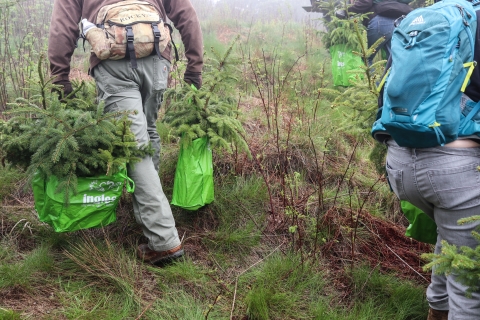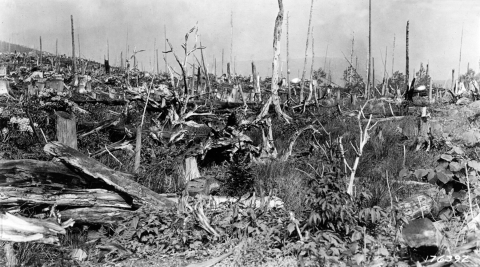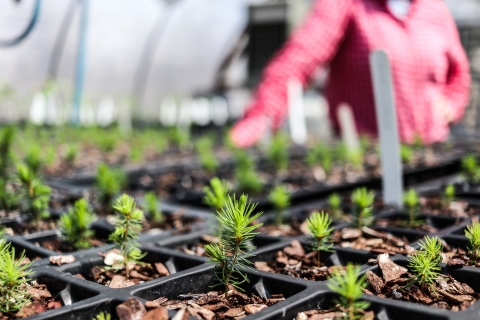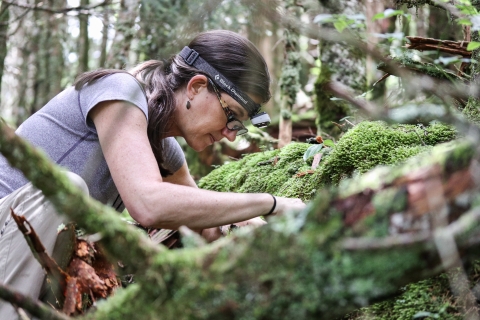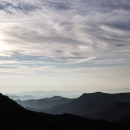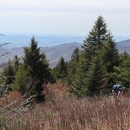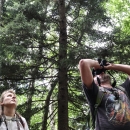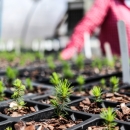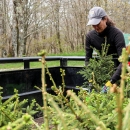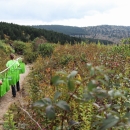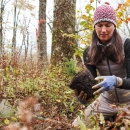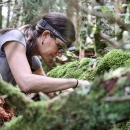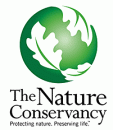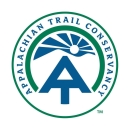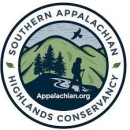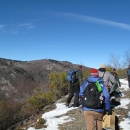States
North Carolina, Tennessee, VirginiaEcosystem
Forest, MountainAt 6,684 feet, Mount Mitchell, in Yancey County, N.C., is the highest peak east of the Mississippi River. To its north, across the Toe River Valley, is Roan Mountain, topping out at 6,285 feet. Just to the east, Grandfather Mountain comes in at 5,946 feet.
In total, the Southern Appalachians are home to eight “sky islands” – peaks and ranges with unique habitats and a mix of plants and animals that includes those found only on these peaks and others found much further north. These mountain-top pockets of cold, moist climate are functionally islands, surrounded by a “sea” of warmer, drier lower elevation land.
Fraser fir and red spruce are the dominant trees at the tops of these mountains, with Fraser fir favoring the highest elevations. The conifers give way to northern hardwoods like, beech, birch, and maple as elevation drops. This conifer forest is home to the endangered spruce-fir moss spider and Carolina northern flying squirrel.
At the turn of the twentieth century, these areas experienced intense logging and subsequent wildfires severe enough to inhibit natural conifer regeneration. Less conifer forest means less habitat for the animals that depend on it. One hundred years later, a coalition of organizations and individuals, including the Service, have come together to help restore these forests, with a shorter-term focus on red spruce and a longer-term focus on Fraser fir, which faces the added challenge of being the target of an invasive insect, the balsam woolly adelgid.
Location
There are eight sky islands in southern Appalachia, moving from southwest to northeast, they are:
- Great Smoky Mountains
- Plott Balsams
- Great Balsams
- Black Mountains
- Unaka Mountains
- Roan Mountain
- Grandfather Mountain
- Highlands of Virginia/Mt. Rogers
Land ownership and management varies across the sky islands, with the U.S. Forest Service and National Park Service being the predominate landowners, but state parks, non-governmental organizations, and private individuals also own key portions.
History
Logging and fire
In the early twentieth century, industrial-scale logging came to Southern Appalachian spruce-fir forests. This was intense logging, not done with an eye to forest health and long-term sustainability, but rather logging done with an eye to getting wood out and moving on. Although these high-elevation forests naturally see little forest fire, the industrial logging left copious amounts of dead and dry slash, ready to be ignited by lightning or sparks from the trains that carried logs out.
The result? A logged landscape struck by rampant and intense wildlife.
Writing in 1937, Clarence Korstian, a former U.S. Forest Service silviculturist who by that time was a professor at Duke University wrote, “Although the fire hazard in the natural spruce forest is extremely low, heavy cutting leaves a large amount of, slash, which on drying out becomes highly inflammable, creating a hazard so great that almost invariably logging is followed by fire. Such a fire is generally hot enough to kill all live trees not protected by surface moisture, and often leaves large quantities of unconsumed wood to provide abundant fuel for a subsequent fire. A burned area becomes a hazard again as soon as the crop of vegetation following the first fire has created a cover of dry litter sufficient to carry fire over the surface to the dead wood. Ordinarily, however, a slash fire destroys not only the timber, the advance reproduction, and the logging slash left by the cutting, but also the organic matter and the microorganisms of the upper soil layer.”
This destruction of the conifer forest, the young trees, and the organic soil required for spruce and fir seeds to sprout led to fundamental changes in the forest. In 1925, Korstian, joined by D.S. Jeffers of Iowa State College wrote, “Where fire has come, even though only once, the cut-over lands are in a hopeless condition, so far as spruce is concerned. Blackberry and raspberry briars overrun these acres, to be succeeded by fire cherry and yellow birch, which according to count run several thousand an acre and in this region are of no commercial importance.”
The nature of these high-elevation conifer forests had been fundamentally changed.
A European insect compounds the situation
In 1916, the balsam woolly adelgid, a European insect that attacks fir trees, was introduced into Maine (Kotinsky, 1916). It was found on Mount Mitchell in 1957 (Spears 1958) and would subsequently spread to all the Southern Appalachian sky islands.
Though red spruce was not directly impacted by the adelgid, which feeds on fir trees, it was indirectly impacted via increased wind exposure. Doing research at Mt Collins, in Great Smoky Mountains National Park, Richard Busing and Eric Pauley found that red spruce deaths from wind damage increased significantly following the loss of Fraser fir in the forest canopy.
All in all, the twentieth century wasn’t a good one for the mountaintop islands of southern Appalachia.
Southern Appalachian Spruce Restoration Initiative
In 2009, restoring red spruce was on the mind of a handful of people in the Southern Appalachian conservation community and in December, 2012 the first meeting of interested partners occurred in Asheville, N.C., essentially to foster conversation about spruce restoration and gauge interest in moving forward together – to see if forming the Southern Appalachian Spruce Restoration Initiative (SASRI) was a worthwhile and desired endeavor.
Modeled after the existing Central Appalachian Spruce Restoration Initiative, SASRI brings together a variety of partners – private, state, federal, and non-profit - to focus on restoring red spruce in the Southern Appalachians. Different partners bring different motivations, skills, and interests to the table - working collaboratively each organization or individual can take on roles and responsibilities that best align with their greater mission: raising new spruce trees, planting trees, managing existing trees, monitoring restoration, sharing the story of red spruce restoration, or ensuring compliance with environmental laws and regulations.
In subsequent years, SASRI has held near-annual meetings and organized around two parallel committee structures –standing committees are focused on topics important to the overall effort, like research or propagation; while sky island teams are each focused on advancing red spruce restoration on a particular sky island. Participation in any committee or team is voluntary and flows from the interests and organizational mandates of the SASRI participants. Service staff have played a variety of leadership roles in SASRI.
For more information about SASRI, visit www.southernspruce.org.
Significance of restoration
Again in 1937, Clarence Korstian wrote, “In the Southern Appalachians, where spruce forest is found only in the cool climate of the loftiest peaks and ridges, its commercial value is equaled, if not exceeded, by its value as a protection for watersheds in holding the shallow soil to the steep, wet slopes, as a check on the silting up of reservoirs, as a refuge for wild life of many kinds, and as a unique scenic attraction in a region of growing recreational appeal.”
While there are numerous benefits to red spruce restoration, for the U.S. Fish and Wildlife Service, this focus is on wildlife, notably imperiled wildlife.
- Carolina northern flying squirrel – Southern flying squirrels, while charismatic, are…common. However, there are 25 sub-species of the northern flying squirrel – generally found in northern forests from Pennsylvania to Alaska. One of those, the Carolina northern flying squirrel (Glaucomys sabrinus coloratus) is only found on these sky islands of Southern Appalachia, isolated from all the other subspecies. The Carolina northern flying squirrel was placed on the federal threatened and endangered species list in 1985. Not only does it nest in red spruce, but also feeds on truffles, or fungi, that grow amidst the roots of red spruce.
- Spruce-fir moss spider – The spruce-fir moss spider (Microhexura montivaga) lives in moss and liverwort clumps growing beneath a canopy of red spruce and Fraser fir. These mountaintop islands are the only place in the world where the spider is found. It was placed on the federal threatened and endangered species list in 1995.
- Other rare wildlife that inhabit spruce-fir forests and benefit from restoration include red crossbill, northern saw-whet owl, brown creeper and Weller's salamander
Red spruce restoration should also help provide a bulwark against the impacts of climate change climate change
Climate change includes both global warming driven by human-induced emissions of greenhouse gases and the resulting large-scale shifts in weather patterns. Though there have been previous periods of climatic change, since the mid-20th century humans have had an unprecedented impact on Earth's climate system and caused change on a global scale.
Learn more about climate change . Climate-wise, two things tend to define the sky island – cold temperatures and high moisture, which often comes in the form of fog or light drizzle. Expanding and connecting red spruce stands increases habitat and habitat connectivity, which should provide a level of resilience for the species that depend on these stands.
Sources
- Busing, R. T., and E. F. Pauley. “Mortality Trends in a Southern Appalachian Red Spruce Population.” Forest Ecology and Management, vol. 64, no. 1, Elsevier BV, Mar. 1994, pp. 41–45.
- Jeffers, D.S., and C.K. Korstian. “On The Trail of the Vanishing Spruce.” The Scientific Monthly, vol. 20, no. 4, Apr. 1925, pp. 358–68.
- Korstian, Clarence F. “Perpetuation of Spruce on Cut‐Over and Burned Lands in the Higher Southern Appalachian Mountains.” Ecological Monographs, vol. 7, no. 1, Wiley, Jan. 1937, pp. 125–67.
- Kotinsky, J. 1916. “The European Fir Trunk Bark Louse (Chermes (Dreyf fusia) Piceae ratz.). Apparently Long Established in the United States.” Proceedings of the Entomological Society of Washington, vol 18, no. 1, pp. 14-16.
- Speers, C.F., “The Balsam Wooly Aphid in the Southeast.” Journal of Forestry, vol. 56, no. 7, 1958, pp. 515-516.
- U.S. Fish and Wildlife Service. “Endangered and Threatened Wildlife and Plants; Determination of Endangered Status for Two Kinds of Northern Flying Squirrel.” Federal Register, vol. 50, no. 126, July 1985, pp. 26999–2702.
- U.S. Fish and Wildlife Service. “Endangered and Threatened Wildlife and Plants; Spruce-Fir Moss Spider Determined to Be Endangered.” Federal Register, vol. 60, no. 24, Feb. 1995, pp. 6968–74.

